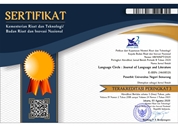ANALYSIS OF ESA TEACHING SEQUENCES APPLIED BY THE ENGLISH TEACHERS FOR JUNIOR HIGH SCHOOL STUDENTS: A CASE STUDY
(1) Sultan Agung Islamic University, Semarang
Abstract
Up to now the results of teaching and learning process related to the students’ engagement and readiness to study as perceived by junior high school students have not been satisfying yet. The students’ engagement and readiness are not considered as important elements before going through the lesson. Students are mostly considered as empty vessels who are ready to be filled with knowledge by English teachers. As a matter of fact, students need encouraging since at the beginning of the lesson in order to achieve their maximum capacity in learning. Regarding with those important elements, there is an interesting teaching sequence namely E-S-A teaching sequence proposed by Harmer (2007) which can create a very interesting and succesful teaching and learning process. This paper therefore discusses the application of E-S-A teaching sequence which includes the students’ engagement during the teaching learning process, and the kinds of E-S-A teaching sequences for teaching junior high school students. The engagement indicators indentified five criteria such as body language, consistent focus, verbal participation, student’s confidence, fun and excitement. The data were taken from the two English teachers as the subjects of this study. The two English teachers’ performance towards the application of E-S-A teaching sequence were analyzed and compared. The result of this study presents the students’ engagement during the teaching and learning process and various kinds of E-S-A teaching sequence which were employed by English teachers to teach students as appropriate.
Keywords
Full Text:
PDFReferences
Best, W.J. 1981. Research in education. New Jersey: Prentice-Hall, Inc.
Bryman, A. and R.G. Burgess. 1994. Analyzing qualitative data. London: Routledge.
Cresswell, J.W. 1994. Research design qualitative and quantitative approaches. California: SAGE Publications, Inc.
Harmer, J. 2001. The practice of English language teaching. (3rd ed.). Essex: Pearson Education Limited.
Harmer, J. 2007. How to teach English. Essex: Pearson Education Limited.
Karjo, Carla H. 2011. “Teachers’ and Learners’ Accounts of Teaching Learning Strategies in Multi Channel Learning System”. Indonesian Journal of Applied Linguistics. Vol. 1/1.
Jones, R.D. 2009. Student engagement teacher handbook. New York: International for Leadership in Education.
Krashen, D.S. 1982. Principles and practices in Language acquisition. California: Pergamon Press Inc.
Lewis, M. 1996. Implications of A Lexical View of Language. In D. Willis & J. Willis (Eds.), Challenge and Change in Language Teaching (p.10-16). Oxford: Heinemann.
Paul, D. 2003. Teaching English to children in asia. Hong Kong: Person Education Asia Limited.
Sanchez, A. 1993. Hacia un metodo integral en la ensenanza de idiomas. Madrid: SGEL, S.A.
Sanchez, A. 2004. Ensenanza y aprendizaje en la clase de idiomas. Madrid: SGEL, S.A.
Sanchez, C. Raquel. 2008. Patterns of Activity Sequencing in the Teaching of English as A Foreign Language and Their Effects on Learning: A Quasi-Experimental Study. Doctoral Thesis of University of Murcia.
Willis, J. 1993. Preaching What We Practice – Training What We Teach: Task-based Language Learning as An Alternative to P.P.P. The Teacher Trainer, 8(1), 17-20.
Refbacks
- There are currently no refbacks.

This work is licensed under a Creative Commons Attribution 4.0 International License

